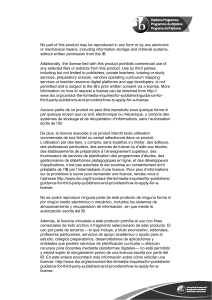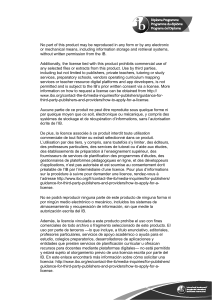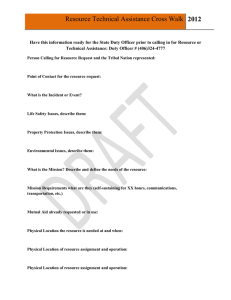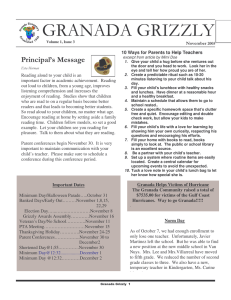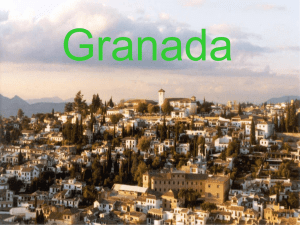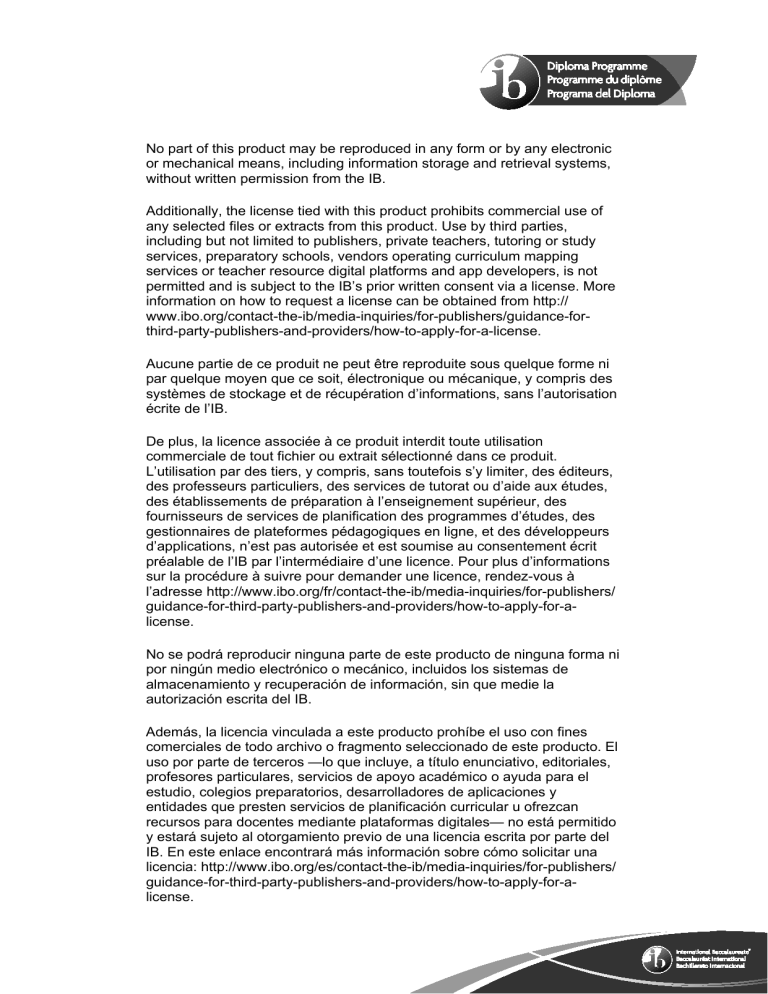
No part of this product may be reproduced in any form or by any electronic or mechanical means, including information storage and retrieval systems, without written permission from the IB. Additionally, the license tied with this product prohibits commercial use of any selected files or extracts from this product. Use by third parties, including but not limited to publishers, private teachers, tutoring or study services, preparatory schools, vendors operating curriculum mapping services or teacher resource digital platforms and app developers, is not permitted and is subject to the IB’s prior written consent via a license. More information on how to request a license can be obtained from http:// www.ibo.org/contact-the-ib/media-inquiries/for-publishers/guidance-forthird-party-publishers-and-providers/how-to-apply-for-a-license. Aucune partie de ce produit ne peut être reproduite sous quelque forme ni par quelque moyen que ce soit, électronique ou mécanique, y compris des systèmes de stockage et de récupération d’informations, sans l’autorisation écrite de l’IB. De plus, la licence associée à ce produit interdit toute utilisation commerciale de tout fichier ou extrait sélectionné dans ce produit. L’utilisation par des tiers, y compris, sans toutefois s’y limiter, des éditeurs, des professeurs particuliers, des services de tutorat ou d’aide aux études, des établissements de préparation à l’enseignement supérieur, des fournisseurs de services de planification des programmes d’études, des gestionnaires de plateformes pédagogiques en ligne, et des développeurs d’applications, n’est pas autorisée et est soumise au consentement écrit préalable de l’IB par l’intermédiaire d’une licence. Pour plus d’informations sur la procédure à suivre pour demander une licence, rendez-vous à l’adresse http://www.ibo.org/fr/contact-the-ib/media-inquiries/for-publishers/ guidance-for-third-party-publishers-and-providers/how-to-apply-for-alicense. No se podrá reproducir ninguna parte de este producto de ninguna forma ni por ningún medio electrónico o mecánico, incluidos los sistemas de almacenamiento y recuperación de información, sin que medie la autorización escrita del IB. Además, la licencia vinculada a este producto prohíbe el uso con fines comerciales de todo archivo o fragmento seleccionado de este producto. El uso por parte de terceros —lo que incluye, a título enunciativo, editoriales, profesores particulares, servicios de apoyo académico o ayuda para el estudio, colegios preparatorios, desarrolladores de aplicaciones y entidades que presten servicios de planificación curricular u ofrezcan recursos para docentes mediante plataformas digitales— no está permitido y estará sujeto al otorgamiento previo de una licencia escrita por parte del IB. En este enlace encontrará más información sobre cómo solicitar una licencia: http://www.ibo.org/es/contact-the-ib/media-inquiries/for-publishers/ guidance-for-third-party-publishers-and-providers/how-to-apply-for-alicense. M19/3/HISTX/BP1/ENG/TZ0/XX/Q History Higher level and standard level Paper 1 Tuesday 7 May 2019 (afternoon) 1 hour Instructions to candidates yyDo not open this examination paper until instructed to do so. yyThe history higher level and standard level paper 1 source booklet is required for this examination paper. yyAnswer all questions from one prescribed subject using the relevant sources in the source booklet. yyThe maximum mark for this examination paper is [24 marks]. Prescribed subject Questions 1: M ilitary leaders 1–4 2: C onquest and its impact 5–8 3: The move to global war 9 – 12 4: R ights and protest 13 – 16 5: C onflict and intervention 17 – 20 4 pages 2219 – 5301 © International Baccalaureate Organization 2019 –2– M19/3/HISTX/BP1/ENG/TZ0/XX/Q Prescribed subject 1: Military leaders Read sources A to D in the source booklet and answer questions 1 to 4. The sources and questions relate to case study 1: Genghis Khan c1200–1227 — Leadership: rise to power; uniting of rival tribes. 1. (a)What, according to Source A, were the consequences of the struggle between Temujin [Genghis] and Togrul? [3] (b) What does Source D suggest about the power of Genghis Khan by 1207? [2] 2. With reference to its origin, purpose and content, analyse the value and limitations of Source C for an historian studying the rise to power of Genghis Khan. [4] 3. Compare and contrast what Sources B and C reveal about Genghis Khan’s [Temujin’s] fight with the Naiman in 1204. [6] 4. Using the sources and your own knowledge, to what extent do you agree that Genghis Khan rose to power because of his military strength? [9] Prescribed subject 2: Conquest and its impact Read sources E to H in the source booklet and answer questions 5 to 8. The sources and questions relate to case study 1: The final stages of Muslim rule in Spain — Key events and actors: the Granada War and the conquest of Granada (1482–1492). 5. (a)What, according to Source F, were the consequences for the Moors of the war and conquest of Granada? [3] (b) [2] What does Source G suggest about the conquest of Granada? 6. With reference to its origin, purpose and content, analyse the value and limitations of Source F for an historian studying the Christian war against Granada. 7. Compare and contrast what Sources E and H reveal about the Christian war against Granada. [6] 8. Using the sources and your own knowledge, to what extent do you agree that the fall of Granada was caused by internal weaknesses in Granada? [4] [9] –3– M19/3/HISTX/BP1/ENG/TZ0/XX/Q Prescribed subject 3: The move to global war Read sources I to L in the source booklet and answer questions 9 to 12. The sources and questions relate to case study 2: German and Italian expansion (1933–1940) — Responses: international response to German aggression (1933–1938). 9. (a)What, according to Source I, were the conclusions reported to the British government regarding the March 1935 meeting in Berlin? [3] (b) [2] What does Source J suggest about Anglo-German relations in 1935? 10. With reference to its origin, purpose and content, analyse the value and limitations of Source I for an historian studying the international response to German aggression. [4] 11. Compare and contrast what Sources K and L reveal about the attitudes towards German foreign policy under Hitler. [6] 12. Using the sources and your own knowledge, discuss the effectiveness of the international response to German aggression between 1933 and 1938. [9] Prescribed subject 4: Rights and protest Read sources M to P in the source booklet and answer questions 13 to 16. The sources and questions relate to case study 2: Apartheid South Africa (1948–1964) — Protests and action: non-violent protests: Freedom Charter. 13. (a)Why, according to Source M, did Robert Sobukwe oppose working against apartheid with European (white) people? (b) What does Source N suggest about the group of opponents to the government’s apartheid policy? [3] [2] 14. With reference to its origin, purpose and content, analyse the value and limitations of Source O for an historian studying the anti-apartheid movement. [4] 15. Compare and contrast what Sources O and P reveal about the anti-apartheid movement in the 1950s. [6] 16. Using the sources and your own knowledge, to what extent do you agree that, during the 1950s, the struggle against apartheid represented a clash between black and white South Africans. [9] Turn over –4– M19/3/HISTX/BP1/ENG/TZ0/XX/Q Prescribed subject 5: Conflict and intervention Read sources Q to T in the source booklet and answer questions 17 to 20. The sources and questions relate to case study 1: Rwanda (1990–1998) — Course and interventions: role of the media. 17. (a)Why, according to Source Q, did the Hutu masses respond to Hutu propaganda? [3] (b) [2] What does Source T suggest about the role of radio in the Rwandan genocide? 18. With reference to its origin, purpose and content, analyse the value and limitations of Source S for an historian studying the role of the media in the Rwandan genocide. 19. Compare and contrast what Sources R and S reveal about the role of radio in inciting genocide. [6] 20. Using the sources and your own knowledge, evaluate the role of the media in the Rwandan genocide.[9] [4]
